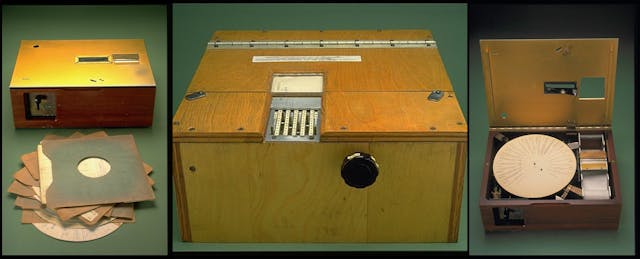Long before the advent of personal computers, inventors and researchers created what they called “teaching machines” in hopes of revolutionizing education. Some of these creations date back to the 1920s, and were made from wood and brass.
Yet today’s edtech leaders often ignore or choose to forget this history, argues Audrey Watters, a longtime critical observer of edtech, who calls it “historical amnesia of the past.”
“It's part of the narrative of this idea [by edtech founders] that, ‘we're innovators and we came up with these ideas and no one, no one has ever thought of this stuff before. So thank goodness we're here to save education,’” she says. “I wanted to show that in fact, people have been using technology in the classroom since the beginning, … and these ideas of personalized learning in particular aren't new either.”
Watters traces the history of these pre-computer-age gadgets in her new book, “Teaching Machines: The History of Personalized Learning.” We connected with Watters for this week’s EdSurge Podcast.
She argues that it’s important for today’s educators and policy leaders to know this history to understand the types of people and institutions who have pushed to bring automation to education. Since the beginning, she adds, there has been a contradiction between the promise of making learning more personalized and the reality that teaching machines often required a higher level of standardization.
“I wanted to tell a story that didn’t have anything to do with computers,” she says, noting how mechanical early teaching machines were. “Because I think that too often in edtech, we get so hung up on the tech,” she adds. “We're so committed to talking about the latest gadget, the new software, this or that app, that we really act as though somehow it's that the tech is all there is to talk about. That the tech is the driving force of change. That the tech is the driving force of history.”
Instead, Watters says, people have been driving an idea of how to use tech in education, an idea that supports a specific narrative of what education should be.
One of the people she focuses on in the book is B.F. Skinner, who invented an early teaching machine when he was a psychology professor at Harvard in the 1950s. He was the kind of public intellectual who would be giving TED talks if he were alive today, and he was a leading proponent of “behaviorism,” which argued that people’s actions can be shaped (some might say manipulated) through positive and negative reinforcements.
He often experimented on pigeons, some of which he even trained to play ping-pong. “And that was really the foundation for his education technology—that we'll build machines and they'll give students—just like pigeons—positive reinforcement and students—just like pigeons—will learn new skills.”
Skinner made a case that his machines would let students learn at their own pace. But Watters worries that by design, the machines limited what students would learn. “There was very, very little freedom in Skinner's vision,” says Watters. “Indeed Skinner wrote a very well-known book, “Beyond Freedom and Dignity” in the early 1970s, in which he said freedom doesn't exist. Freedom as a facade.”
Watters is known for her long-running blog, “Hack Education,” and for her skepticism of and critical look at the edtech industry.
“A lot of people actually accused me of being a pessimist,” she says. “And I'm not a pessimist. I actually am hopeful.”
She says she is currently reading the book “Hope in the Dark,” by Rebecca Solnit, about how studying history can be an important source of hope for the future.
“We're despairing when we don't know the past,” says Watters. “We're despairing when we don't know that people have fought back before, that people have resisted before.”
In her research she discovered people who resisted the teaching machines and determinist philosophy of folks like Skinner: “That's the place I find hope today, is where I see students who are questioning, students who are resisting and communities who are building practices that serve their needs rather than serving the needs of engineers.”


